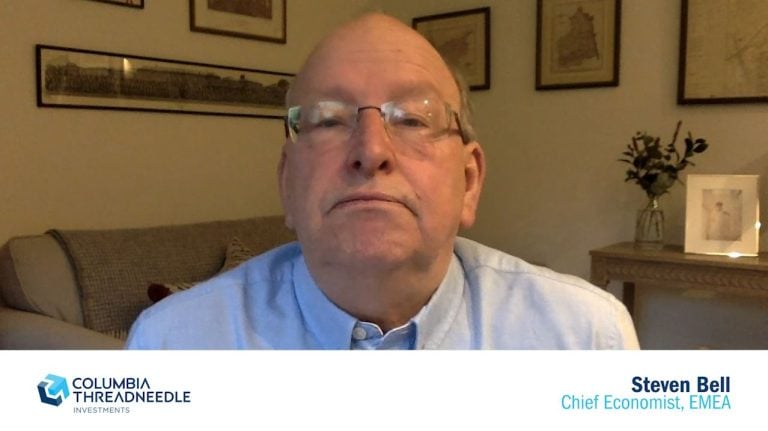We’ve been talking about recession for most of this year. But unemployment has stayed very low in most countries and if you just watched the equity markets, you’d think the risk of recession had receded recently. Most markets are up 10% or so in the last month, led by Europe. So what’s going on?
First, the global economy has done better as summer has turned to autumn. The US consumer has kept on spending fuelled by their covid piggy bank. That’s the pile of cash and reduced debt built up during covid. While European consumers worried about high gas prices, their US counterparts were pleased that the gas price they care about –gasoline – was going down: from over $5 a gallon in June to below $4. Still high by their standards but reassuring in terms of direction.
As a result of this and the tight labour market, consumers have remained reasonably confident. They kept spending despite a squeeze on their incomes. The chart in the video shows a steady increase in consumer spending after adjusting for inflation. It occurred despite a significant fall in household incomes in real terms. The cumulative gap is 6.6%. Had consumer spending fallen in line with the drop in real incomes we would already have had a major recession in the US.
In Europe, confidence was hit hard by the war in Ukraine and the associated surge in energy prices. German industrial production is down by 15% since February. But recently, things have begun to look a little better. The easing of supply shortages has allowed capital expenditure (CAPEX) shipments in the big three developed economies to surge in Q3, by an annualised 18% according to estimates by J.P. Morgan.
That same easing of supply conditions has boosted auto sales in Europe and the US. Indeed, Europe’s hard-pressed consumers had some relief. Although economic data are seasonally adjusted, in the real world it’s different and the pain for households in the northern hemisphere, from high energy prices, was limited in the summer. And while inflation surged unemployment remained remarkably low. Meanwhile, valiant efforts by Germany filled their gas storage and fears of blackouts and rationing over the winter receded.
In recent weeks, forecasters have revised up the projections for growth to the end of this year for both the US and Eurozone economies. Not by much but in sharp contrast to the previous pattern of hefty downward revisions.
So has recession been cancelled? Unfortunately not. Although headline inflation is falling in the US, powerful domestic pressures remain. Wages and rents are rising rapidly. There are plenty of forces pushing inflation down …the lagged effect of the strong dollar, easing of supply constraints (notably in cars), falling commodity prices and base effects. But until and unless there is a meaningful easing in the labour market, the Federal Reserve will keep on tightening. Where that will take interest rates no one knows for sure – and that includes the Fed. But in my view, the US needs a recession to get inflation sustainably on target and my guess is that 5% might be enough …that’s where Fed funds are currently priced for next year. But the risks are to the upside.
If I’m wrong and Fed funds peak below 5% it will be because recession arrives in the first half of next year. Indeed, the signs are that the surge in CAPEX shipments is already over. After a strong Q3, best estimates see zero growth in Q4. And European consumers will start paying those hefty energy bills. Yes, governments have stepped in. Germany has put aside a remarkable € 200bn, that’s 5.2% of GDP, to subsidise consumers and businesses alike. But the bills will still be much higher …double last year’s level.
So recession is still on the horizon in both the US and Eurozone.
What about the UK? Much has been made of Jeremy Hunt’s Autumn Statement. It delays much of the fiscal contraction until after the next election (which has to be held by January 2025). That may be. But the real income squeeze remains. There will be an astonishing 7% fall in real incomes over this year and next according to the Office for Budget Responsibility.
Consumers here have their own covid piggy bank and they probably drew on it over the last few months. And the autumn has been remarkably mild, keeping the energy bills down. But winter is upon us and despite the government support scheme, energy prices have doubled since last year and are set to rise another 20% in April.
Despite the backloading of Hunt’s austerity, stealth taxes are rising and this is especially powerful in these times of high inflation. In contrast to Europe and the US, there has been no increase of growth forecasts for the UK. They have continued to head down. We have probably entered recession here already. Unemployment remains low but that can’t last.
The good news is that inflation here and elsewhere should fall quickly once recession hits. Markets are much more flexible now than they used to be. The imbalances that typically presage deep and protracted recessions are largely absent. I think the newsflow on the world economy, including the UK, will be much more positive at the end of next year than at the beginning.
And so, on that cheery note in an otherwise gloomy outlook, its goodbye until next week.







